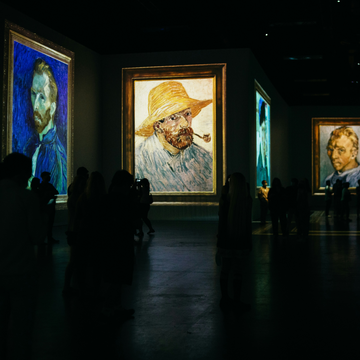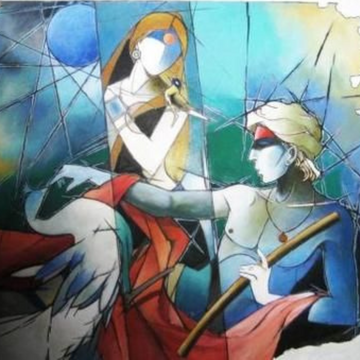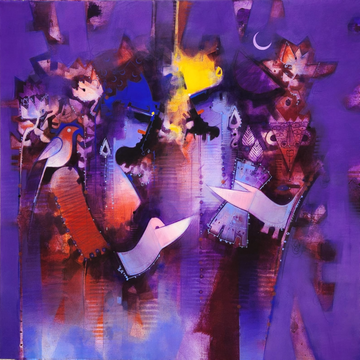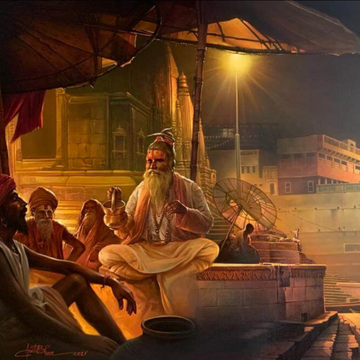The Man with the Straw Hat The Uneasy Life and Troubled Times of Vincent Willem van Gogh (30 March 1853 – 29 July 1890)

By K Kalyanaraman
As for me, I am rather often uneasy in my mind, because I think that my life has not been calm enough; all those bitter disappointments, adversities, changes keep me from developing fully and naturally in my artistic career.
—Vincent van Gogh
Van Gogh died thinking his life was worthless. Today, his every work of art is priceless.


Famous and influential Post-Impressionist figure of Western Art
On November 11, 1987, “Irises” was auctioned at Sotheby's in New York for $53.9 million, the highest price ever paid for a painting. Three years later, “The Portrait of Doctor Gachet” changed hands within three minutes for $82.5 million, as the most expensive painting ever auctioned. The irony is that Vincent only sold one painting during his lifetime and became renowned only after his death. It was “The Red Vineyard" sold in 1680, at Brussels for 400 Belgian francs, roughly equivalent to today’s INR 700!


Acknowledged to be the greatest Dutch painter since Harmenszoon van Rijn Rembrandt, the troubled genius left behind over 2,100 works, comprising 860 oil paintings and more than 1,300 water colours, drawings and sketches.
Vincent van Gogh is one of the most well-known artists in the world. His paintings are relevant across the world even today, and he led from the front, the revolution of ‘tortured artists.'
Birth and early years
Vincent Willem van Gogh was born at a religious Dutch family in 1853 at Groot Zundert, the Netherlands. He was raised in Holland by his minister father. Vincent's family comprised three sisters - Elisabeth, Anna, Wil, two brothers - Theo and Cor, and his parents.

His earliest years presented no inclination towards art or music. The boy studied at a boarding school in Zevenbergen for two years and then at the King Willem II secondary school in Tilburg for the next two. On the face of financial difficulties, Vincent left his studies when he was 15 and joined his uncle’s company of art dealers, Goupil & Cie, Hague, as a young art clerk.
He travelled to England and France and was very happy with his life there. He was also good at his work. He visited all the art galleries and museums in England and greatly admired the writings of George Eliot and Charles Dickens. Vincent also took interest in British engravings.
During this time, there were rumours of his romantic trysts with his landlady’s daughter, Eugenie Loyer. However, Eugenie rejected his interest in her, compelling Vincent to lose his balance. He flung away all his books, except for the Bible and began to turn to God. At his workplace, he advised customers to not to buy their works of art, as they were worthless. He was sacked from his job for this.
But the fact was that the Dutch man was restless. Vincent soon grew frustrated with the art scene in Paris, and became indifferent to the requirements of his trade.
First a preacher, then a painter
Back in the Netherlands, he briefly worked in a bookshop in Dordrecht. There he got interested in theology and showed an intelligent mind, with a flair for languages including Greek and Latin in addition to French, German, English and Dutch.
But he could not qualify for the mission school in Laeken.
But not one to take NO for anything, Vincent took to preaching. To “harden” himself, Vincent began preaching in one of the most desolate and poverty stricken coal mining districts, the Borinage in Belgium. He mingled with the miners and their lives. This left a strong impact on him as depicted in his immediate paintings of the peasant life.
Though he came to be called as the Christ of the Coal Mines, Vincent lacked his father’s forcefulness and the passionate communication skills to preach effectively.
It was Theo who encouraged Vincent to paint. But forget training, Vincent did not even seem to show any interest in art or artists. He was very sceptical about Theo’s suggestions as were their parents, who had now come to accept his somewhat erratic behaviour and changing ideas about life. They lost all hope of Vincent settling down to a steady job.
In 1880, at 27, Vincent entered the Academia Royale des Beaux-Arts in Brussels, Belgium. He began to teach himself to draw and play with several techniques, styles and subjects. He began to experiment with perspective, shading, and anatomy. Clearly impacted by his peasant influences in the Belgian mines, Vincent became adept in sketching figures of ordinary people. He tried to copy the artists of the time, as was the prevailing practice for novice artists. But more than drawing, Vincent began to feel the strong urge to do paintings.
Anthonij Rudolf Mauve, Vincent’s cousin son-in-law, became his teacher. Anton was a leading Dutch realist painter of the time.
A catastrophic love life
Vincent was attracted to women in trouble, thinking he could help them. His cousin, Kate, was recently widowed, and when van Gogh fell in love with her, she was repulsed and fled to Amsterdam. He then moved to the Hague and fell in love with Clasina Maria Hoornik, an alcoholic prostitute, who already had a child out of wedlock. She became his companion, mistress and model.
Anton did not like the arrangement at all and refused all interaction with Vincent. Undeterred, Vincent continued to draw, frequently using Hoomik as a model.
He completed his first painting, ‘The Potato Eaters’ in 1885 from Nuenen, the Netherlands. To be very natural and original, Vincent deliberately chose coarse and ugly models. This painting was the first signs of success for Vincent, but not during his lifespan. Not happy with his ‘originality’, Vincent began to apply himself to the study of the use of colours, particularly, Peter Paul Rubens.


Further events were to prove that though Vincent was very diverse, his paintings were hard to sell. Theo, his brother began to take an interest in his brother’s career and advised him to add more colours in his paintings and to move over from the dull and the drab. That was when, Impressionism, entered the art field in bright and vivid streaks.
Back in Gay Parie
Moving to Paris in 1888, Vincent rented four rooms in a house on Place Lamartine in Arles in the south of France, in a corner building. He began to experiment with his works and mingle with the successful artists of the time like Paul Gaugin, Emile Bernard, Toulouse-Lautrec, and Camille Pissarro, to name the top few. He used more colours, painted in thick, bold brushstrokes, and discarded his original sobriety. He also became very productive, creative and prolific. He was very contented here, and called over his friends for talk, banter and paint.
The artists posed for each other to save money on models. But Vincent was argumentative and critical of other artists’ work and they soon got tired of him. Despite his ‘troublesome nature’, Vincent planned to transform the house into a full-fledged artist’s den, where they could brainstorm, paint and rest as long as they wanted.


Soon after he settled down in this house, Vincent sent his brother a comprehensive description and a drawing of a painting, stating that the houses appeared yellow in the sun and the sky, blue, in contrast. The work, which Van Gogh himself called ‘The Street’, records the artist’s immediate surroundings. The painting shows the place where he ate, and the home of the local postman and friend, Joseph Roulin.
Vincent added that the ground was yellow and promised Theo that he will soon send a better sketch. The 'better sketch' was never shifted from the Vincent van Gogh property. The painting is in the custody of the Vincent van Gogh Foundation, at the Van Gogh Museum, Amsterdam, thanks to the efforts of Vincent Willem van Gogh, the artist's nephew.
As for the ‘yellow building’, itself, it was severely damaged due to the Allies bombing in 1944 and then demolished by the end of World War II.


Tournesols, or more famously known as 'Sunflowers' were a series of paintings van Gogh developed in 1887, meant to decorate the house he stayed with Paul Gaugin. In the first release, Vincent painted the sunflowers lying on the floor but later began to start putting them into flower vases.
Mental illness and physical decline
However, the stay in Paris also was a time of great turmoil for Vincent, with a period of hospital stays for mental illness and physical decline.
Theo was worried, and requested Paul Gauguin to take care of Vincent. He even gave Gaugin some money for the expenses. However, Vincent had arguments with Gaugin all the time, so much that Gaugin had to stomp out of his own house. A desperately running Vincent overtook the post-impressionist French artist, brandishing a shaving razor. He then entered a local brothel and paid a prostitute, Rachel, to keep a part of his ear ‘safely’ that he had chopped off. The police found Vincent in his room the next morning and admitted him to the Hôtel-Dieu hospital, the oldest one in Paris. By then he was weak with blood loss and bouts of violent seizures.
Vincent began to display his erratic self and left Hoomik, to go back to fellow artists, Van Rappard and Anton Mauve. Hoomik turned back to prostitution.
Unable to break away from his exposure to peasants, Vincent gained inspiration from Jean-François Millet, a French artist, renowned for his representations of the French peasant life. By this time, Vincent was no longer staying with his parents and had rented a small shack to himself.
Towards the end of 1888, the first signs of van Gogh's mental illness became manifest. He lived on coffee and bread by the morning and absinthe by the evening. At times, he was known to have sipped turpentine and eaten paint. Naturally, he felt sick and nauseous all the time. Those who were with him realized that he had some kind of physical illness and that his psychological health was also on decline.
So much so, van Gogh himself walked into the Saint-Paul asylum, to seek help.
Even under treatment at the Saint-Paul asylum, Van Gogh displayed uneasiness, illness and there were periods when he lay sick and unable to paint. Morbid thoughts occupied his mind and he often contemplated suicide.
He was at peace only when he could paint and get consumed by the feel of brush on canvas and the smell of paint. His paintings began to show the 'uselessness and shallowness' of life on the face of Mother Nature. Only his natural surroundings became his friends. The trees, the flowers, wilting though they were at times, the bright sunny landscape, or the vineyards and the small crawling creatures, were his life and blood. He began to see the transformation of flowers as a representation of birth, life and death.
One of the many paintings van Gogh attempted here was the 'Irises.' Despite the boring and monotonous hospital interiors and his own sad state of mind, van Gogh could gain absolute solace by looking out of an east facing window, from his confinement.
On occasional walks in the outside, van Gogh painted other pictures like the 'Olive Trees' and several landscapes, all of them, extremely profound, as art analysts later began to unanimously agree. All of his works, according to experts seem to have one common factor - fragility.
During his better times, Vincent began to paint like mad, for short bursts, as if inspired from above. It was here that Vincent created ‘The Starry Night’, his most popular and influential work. Art analysts seem to think that the swirls in this painting is a reflection of his confused mental state. In fact, all of his following works painted from the asylum, show a swirly effect.
During much of his stay in the asylum, van Gogh was isolated confinement. When he did walk around the grounds of the asylum, he made paintings of the garden, the enclosed wheat field that he could see outside his room and a few portraits of individuals at the asylum.


Though a very disturbed man, Vincent left Saint-Rémy-de-Provence in 1890, he created an impossible tally of almost one painting, each day. Nevertheless, totally lacking in self - esteem by now, Vincent began to see his life as a complete waste, a failure on all counts including health, money and love, leave aside his creative satisfaction.
Theo began to search for a home for Vincent when the asylum had nothing more to offer. He learned from one of the patients, about Dr. Paul-Ferdinand Gachet, a French physician and an amateur painter, signing his works 'Paul van Ryssel'. The doctor seemed to understand the mental plight of artists of the time and was a great fan of Impressionism. He mingled with Paul Cezanne, Camille Pissarro, Claude Monet, and Auguste Renoir.
To the much worried Theo, Vincent seemed to fit the bill of an ideal patient. Upon discussions with the doctor, Theo admitted Vincent to his home in Auvers-sur-Oise, a commune in the northwest of Paris.


At first, Vincent did not like Dr Gachet at all. He remarked to Theo that the doctor was not the right person to take care of him, given the circumstances. According to Vincent, the doctor looked sicker than him and it was ‘a blind case of the blind leading the blind.’
However, things changed rapidly. Vincent wrote to his sister that the doctor and he got along like a house on fire and it was like two mad people having roaring fun.
Vincent thought that a portrait of Dr Gachet would bring him the much wanted fame and money. He began to work on the painting with his natural speed and focus. In fact, he went on to paint two portraits of the doctor, almost back to back, as well as 'Church at Auvers' and 'The Cornfield'. It is said that this period was also van Gogh's most prolific, the last two months of his life.
There is a theory that Vincent was inspired by the French romantic painter Eugène Delacroix's painting of Torquato Tasso, the 16th century Italian poet, confined to the madhouse. Seeing this painting at a Montpellier museum, along with his friend Gaugin, van Gogh wrote to Theo, if he could get a lithograph of this French painting.
As subsequent events unfolded, Gachet was much criticised after the death of van Gogh. However, many felt that there was not much the doctor could do. Vincent was far gone, and he never really heeded his doctor’s instructions to cut down on his drinking and smoking. Van Gogh made it difficult for himself by being stubborn.


'Wheat Field with Crows', showing the fields of Auvers-sur-Oise is considered to be Vincent van Gogh's last work of art, painted in July of 1890. Van Gogh did this as a double square canvas, where two squares are joined as one. In his final days, almost of all his paintings were done as double canvases, perhaps his idea of a larger than life interpretation.
On July 27, 1890 Vincent shot himself in the chest and passed away two days later.


Life like a Greek tragedy
Theo, who painstakingly saved most of his brother’s paintings, died of syphilis six months later. Johanna van Gogh-Bonger, his wife, displayed an admirable presence of mind and wisdom. Had it not been for her, the world would have never seen much of Vincent van Gogh or his world famous works. In her native Holland, she involved herself to promote the works of her brother-in-law and claimed the fame, he rightly deserved. Needless to add, any description of art today, is incomplete without mentioning Vincent van Gogh.
Hundreds of physicians and psychiatrists have tried to define van Gogh's medical conditions over the years. They included temporal lobe epilepsy, bipolar disorder, Thujone poisoning, lead poisoning, hypergraphia (intense desire to write) and sunstroke. No wonder, the tortured artist wrote over 900 letters, out of which 650 were to his brother, Theo.

Posthumous fame
Vincent’s paintings have astounded the whole world, art connoisseurs, art students and the general public, alike. Art dealers instantly cock their ears at the mention of a van Gogh. His paintings exchange hands at astonishingly high prices. Ironically, he gained fame after his death and sold only one painting in his entire life time.
‘Sunflowers’ has brushed its way to a new world of decor and art. Despite the creation of a series of exaggerated perspectives, typical colour schemes and monotonously beautiful flowers in a minimalistic setting, the painting has inspired many artists to paint sunflowers, even where they do not grow!
As Vincent himself said, “The heart of man is very much like the sea, it has its storms, it has its tides and in its depths it has its pearls too."
Vincent’s desire to express himself through spirituality and nature set the brush strokes for dramatic, imaginative, rhythmic, and emotional canvases that convey far more than mere graphics. These methods and practice came to define many subsequent modern movements from Fauvism to Abstract Expressionism.
His vast and diverse array of art has been copied by thousands, but duplicated by none. His unique life has inspired millions to become active in art. He gave style and substance to the life of an artist.
Vincent van Gogh will never go out of fashion.













